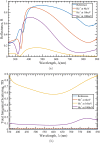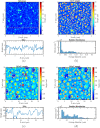Dependence of the damage in optical metal/dielectric coatings on the energy of ions in irradiation experiments for space qualification
- PMID: 33564030
- PMCID: PMC7873038
- DOI: 10.1038/s41598-021-82860-7
Dependence of the damage in optical metal/dielectric coatings on the energy of ions in irradiation experiments for space qualification
Abstract
Terrestrial accelerator facilities can generate ion beams which enable the testing of the resistance of materials and thin film coatings to be used in the space environment. In this work, a [Formula: see text]/Al bi-layer coating has been irradiated with a [Formula: see text] beam at three different energies. The same flux and dose have been used in order to investigate the damage dependence on the energy. The energies were selected to be in the range 4-100 keV, in order to consider those associated to the quiet solar wind and to the particles present in the near-Earth space environment. The optical, morphological and structural modifications have been investigated by using various techniques. Surprisingly, the most damaged sample is the one irradiated at the intermediate energy, which, on the other hand, corresponds to the case in which the interface between the two layers is more stressed. Results demonstrate that ion energies for irradiation tests must be carefully selected to properly qualify space components.
Conflict of interest statement
The authors declare no competing interests.
Figures








References
-
- Garrett H, Jun I, Evans R, Kim D, Brinza W. The latest Jovian-trapped proton and heavy ion models. IEEE Trans. Nucl. Sci. 2017;64(11):2802. doi: 10.1109/TNS.2017.2755618. - DOI
-
- Garoli D, et al. Mirrors for space telescopes: degradation issues. Appl. Sci. 2020;10(21):7538. doi: 10.3390/app10217538. - DOI
-
- Barth JL, Dyer CS, Stassinopoulos EG. Space, atmospheric, and terrestrial radiation environments. IEEE Trans. Nucl. Sci. 2003;50(3):466–482. doi: 10.1109/TNS.2003.813131. - DOI
-
- ESA. Solar orbiter environmental specification - issue 3.0. 2010.
-
- Kollmann P, et al. Properties of planetward ion flows in venus magnetotail. Icarus. 2016;274:73–82. doi: 10.1016/j.icarus.2016.02.053. - DOI
Grants and funding
- ESA contract no. 4000122836 /18 /NL /PS /gp/European Space Agency
- ASI-INAF I/013/12/0 Solar Orbiter/Agenzia Spaziale Italiana
- ASA NIAC Phase I NNX15AL91G/NASA/NASA/United States
- NASA NIAC Phase II NNX16AL32G/NASA/NASA/United States
- the NASA California Space Grant NASA NNX10AT93H/NASA/NASA/United States
LinkOut - more resources
Full Text Sources
Other Literature Sources

